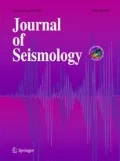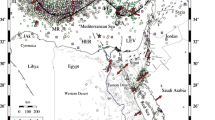Abstract
A local magnitude scale has been developed for Eastern Dharwar Craton (EDC) and adjoining areas around Southern Peninsular Shield, India, to improve the scale used previously in this region. Measurements, 1333 of peak amplitudes on simulated Wood-Anderson instruments located in Andhra Pradesh and Telangana (APTS) network for 91 earthquakes recorded at 26 seismic stations have been used to determine a new distance correction curve for routine in calculating the local magnitudes. The new ML scale has been derived using the Grey Wolf Optimization (GWO), a swarm intelligence-based global optimization technique for the first time: \({M}_{\mathrm{L }}=\mathrm{log}A+1.2588\mathrm{log}R +0.0002789R-2.2265\), where A is the amplitude measured in millimeters, and R is the hypocentral distance in kilometers. The new ML scale derived here is valid up to 400 km. This study has been carried out using both singular value decomposition (SVD) and GWO to obtain scale coefficients and station corrections. The newly derived scale has a drop of 21.37% in the overall standard deviation of all magnitude residuals when station corrections are considered in comparison to the previously used scale. A new ML-MW relationship was derived for local magnitudes above 2.5, and the relationship was MW α 0.9224*ML. In our study, the results obtained using GWO gave less standard deviation of all magnitude residuals for the Eastern Dharwar Craton, thus proving to be better than the conventional SVD approach.











Similar content being viewed by others
References
Agarwal A, Chandra A, Shalivahan S, Singh RK (2018) Grey wolf optimizer: a new strategy to invert geophysical data sets. Geophys Prospect 66(6):1215–1226
Alsaker A, Kvamme LB, Hansen RA, Dahle A, Bungum H (1991) The ML scale in Norway. Bull Seismol Soc Am 379–398
Bakun WH, Joyner W. B (1984) The ML scale in central California. Bull Seismol Soc Am 1827–1843
Balakrishnan S, Hanson GN, Rajamani V (1999) U-Pb ages for zircon and titanite from the Ramagiri area, southern India: evidence for accretionary origin of the Eastern Dharwar Craton during the late Archean. J Geol 107:69–86
Bobbio A, Vassallo M, Festa G (2009) A local magnitude scale for Southern Italy. Bull Seismol Soc Am 2461–2470
Deichmann N (2006) Local magnitude, a moment revisited. Bull Seismol Soc Am 1267–1277
Ericson U (1971) Maximum likelihood linear fitting when both variables have normal and correlated errors. Försvaretsforskningsanstalt, Issue Report C, pp 4474-A1
Gutenberg B (1957) Effects of ground on earthquake motions. Bull Seismol Soc Am 221–250
Havskov J, Ottemoller L (1999) SEISAN earthquake analysis software. Seismol Soc Am 532–534
Hutton LK, Boore David M (1987) The ML scale in southern California. Bull Seismol Soc Am 2074–2094
Kanamori H (1977) The energy release in great earthquakes. J Geophys Res 2981–2987
Menke W (1989) Geophysical data analysis: discrete inverse theory. Int Geophys Ser 45:289
Mirjalili S, Mirjalili SM, Lewis A (2014) Grey wolf optimizer. Adv Eng Softw pp 46–61
Ottemöller L, Sargeant S (2013) A local magnitude scale ML for the United Kingdom. Bull Seismol Soc Am 2884–2893
Press WH, Flannery BP, Teukolsky SA, Vetterling WT (1986) Numerical recipes. Cambridge Univ. Press, New York, p 702
Ramam PK, Murthy VN (1997) Geology of Andhra Pradesh. Geological Society of India, Bangalore, p 245
Richter C (1935) An instrumental earthquake magnitude scale. Bull Seismol Soc Am pp 1–32
Sargeant S, Ottemöller L (2009) Lg wave attenuation in Britain. Geophys Int 1593–1606
Urhammer RA, Collins ER (1990) Synthesis of Wood-Anderson seismograms from broadband digital records. Bull Seismol Soc Am 702–716
Vashisth D, Shekar B (2019) Inversion of Rayleigh-Wave Phase and Group Velocity Dispersion Curves for S-Wave Velocity by Grey Wolf Optimization. s.l., European Association of Geoscientists & Engineers, pp 1–5
Acknowledgements
I would like to thank the Director, CSIR-NGRI, for his permission to allow me for summer training in this institute. I took inspiration from Ottemöller and Sargeant (2013), while preparing figures.
Author information
Authors and Affiliations
Contributions
Aman Sharma: conceptualization, methodology, software; Divakar Vashisth: methodology, software; Naresh Bandari: data curation, software; G Suresh: data curation, investigation; P Solomon Raju: conceptualization, methodology, original draft preparation; R Vijaya Raghavan: software, D Srinagesh: supervision, validation, reviewing and editing.
Corresponding author
Ethics declarations
Competing interest
The authors declare no competing interests.
Additional information
Publisher's note
Springer Nature remains neutral with regard to jurisdictional claims in published maps and institutional affiliations.
Highlights
In this study, we calibrated a new ML scale for EDC and adjoining regions (Southern Peninsular Shield, India), which could replace the earlier used ML scale for computing local magnitudes in this region.
We processed waveforms from about 91 earthquakes to extract synthetic Wood-Anderson displacements over which the measurements of peak amplitude were performed. Following the original definition of Richter, we used both the horizontal components of the simulated Wood-Anderson seismogram for amplitude picks.
We performed SVD and GWO inversion on our dataset and derived the values of scale coefficients and correction coefficients and calculated the magnitude residual for assessment of the new relationship.
This scale has a drop of 21.37% in the overall standard deviation of all magnitude residuals when station corrections are considered.
Rights and permissions
About this article
Cite this article
Sharma, A., Vashisth, D., Naresh, B. et al. An ML scale for Eastern Dharwar Craton and adjoining regions. J Seismol 25, 1251–1263 (2021). https://doi.org/10.1007/s10950-021-10028-x
Received:
Accepted:
Published:
Issue Date:
DOI: https://doi.org/10.1007/s10950-021-10028-x




